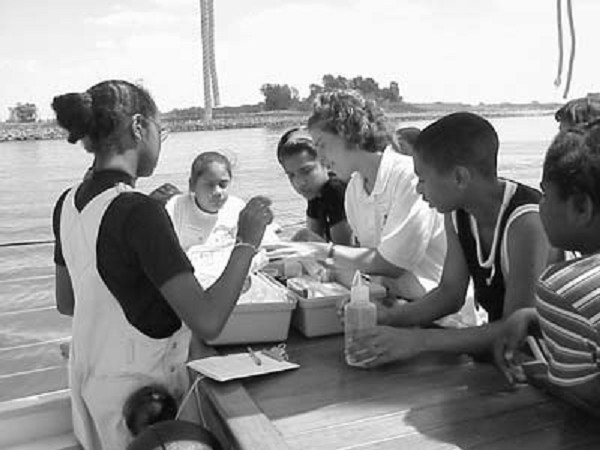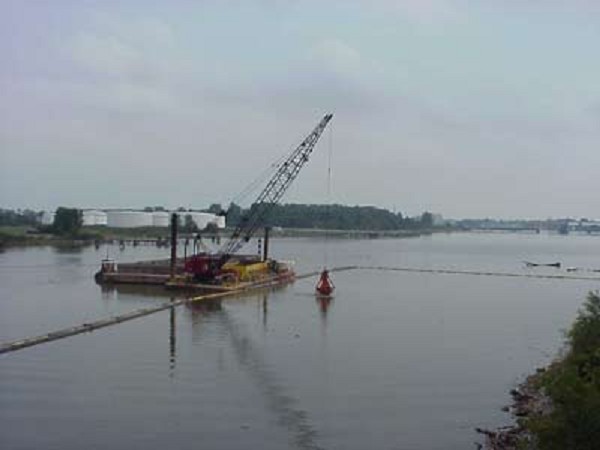BETTER WALLEYE? Saginaw River Channel Deepening Seen Aiding Fish Quality
|
||||||||||
| Printer Friendly Story View |

Students learn benefits of water quality monitoring in Saginaw River. (EPA Photo.)

Dredging on Saginaw River to begin in next two weeks, last until late June. (EPA Photo.)
Cleaner fish in the Saginaw River is one expected benefit of a dredging project slated to begin in the next two weeks.
The Michigan Department of Environmental Quality (MDEQ) reports that environmental benefit of dredging the Upper Saginaw River is to remove the contaminated sediment from the bottom of the river.
This will reduce the amount of contaminated material subjected to movement by storm events and ship passage and decrease the amount of pollutants available to bottom dwelling organisms on which many fish feed.
General Motors Corp. factories and municipal wastewater treatment plants dumped PCBs in the Saginaw River beginning in the 1940s, according to the U.S. Fish and Wildlife Service. In 1998, that agency, the state of Michigan and the Saginaw Chippewa Tribe reached a settlement with General Motors Corp. and the cities of Saginaw and Bay City to pay for the dredging at that time.
The U.S. Army Corps of Engineers, Detroit District, has awarded a $1.7 million contract to Luedtke Engineering Co., Frankfort, for dredging of Saginaw River and Saginaw Bay.
Dredging is slated to begin in early May and wrap up by late June.
Meanwhile, the International Association for Great Lakes Research has reported its conclusions on record hatches of walleye.
"Walleye has been stocked almost annually in Saginaw Bay since 1978, and their population has little natural reproduction despite abundant adults. This changed suddenly in 2003-2005, when record high levels of natural recruitment were observed.
"Researchers from the U.S. Geological Survey and Michigan Department of Natural Resources (MDNR) teamed up to try and learn the reason for this change. Saginaw Bay is well-studied, so they compiled a broad array of environmental data from the bay to see which environmental patterns best explained the recent record hatches.
"It turned out that the most likely explanation was recent low alewife abundance, and not weather patterns as has been thought previously. David Fielder, an MDNR research biologist says "we believe that poor walleye reproduction prior to 2003 was due to adult alewive preying on or competing with walleye fry just after they hatch. As soon as the alewive declined in Lake Huron, walleye reproductive success greatly increased for three years in a row despite very different spring conditions."
Findings from this study may allow MDNR to adjust stocking rates by predicting years when natural walleye reproduction will occur. This study also indicates that the decline in Lake Huron alewife, while bad for Chinook salmon, had positive effects in Saginaw Bay.
Economic benefits of greater channel depth also result from the dredging.
"The Saginaw River is an important passage for marine cargo including cement, coal, limestone, salt, potash and grain -- products that help fuel the local economy and support jobs," said Lt. Col. Robert Ells, district engineer.
"The Detroit District is pleased to award this dredging contract, which will help ensure that marine commerce keeps moving in and out of the Saginaw region in an environmentally friendly manner."
Mike Seward, president and CEO of the Bay Area Chamber of Commerce, commented:
"I think the dredging will have a very positive impact on businesses along the water front and these businesses will begin to see better service."
Two years ago a report showed PCB levels in Saginaw Bay walleye had dropped 80 percent since 1997. According to Chuck Madenjian, a fishery biologist at the U.S. Geological Survey's Great Lakes Science Center, the drop was due to a dredging project in 2000 and 2001 that pulled more than 340,000 cubic yards of polluted sediment out of the Saginaw River, the bay's main tributary.
This year Luedtke will dredge a total of 203,470 cubic yards from two portions of the river. This includes 153,470 cubic yards of material to be dredged between the Independence Bridge in northern Bay City and the mouth of the river about three miles away.
The contractor will deposit the dredged material in the Saginaw Bay Confined Disposal Facility, CDF, located two miles out in the bay.
The channel extends the entire length of the Saginaw River, upstream from the confluence of the Tittabawassee and Shiawassee Rivers out to the 27 foot depth contour in Saginaw Bay (about 14 miles out in the bay). The navigation channel is 200 feet wide in the river and 350 feet wide in the bay. Channel depth varies from 16.5 feet at the upstream end to 27 feet in the Bay.
The firm will dredge an additional 50,000 cubic yards of material upstream in eastern Saginaw County, to be deposited in the Upper Saginaw River Dredged Material Disposal Facility, DMDF, which straddles the Bay-Saginaw county line.
The contract was awarded under the Corps Multiple Award Task Order Contract, MATOC, which the Detroit District established with 10 companies capable of dredging in the Great Lakes. The MATOC is designed to provide greater flexibility and expedite the bid solicitation-award process for dredging in Great Lakes commercial shipping channels and harbors.
The U.S. Army Corps of Engineers, Detroit District, maintains a navigation system of 91 harbors and four connecting channels, including the channels joining lakes Superior, Michigan, Huron, St. Clair and Erie. For more details, contact Lynn Rose, public affairs officer, 313-226-4680, or Mollie Mahoney, project manager, 313-226-2033.
To see the latest condition surveys of the areas to be dredged, visit http://www.lre.usace.army.mil.
| Printer Friendly Story View |
|
|

Dave Rogers |
|
|
|
Printer-Friendly Story View
0200 Nd: 04-20-2024 d 4 cpr 0
12/31/2020 P3v3-0200-Ad.cfm
SPONSORED LINKS
12/31/2020 drop ads P3v3-0200-Ad.cfm


